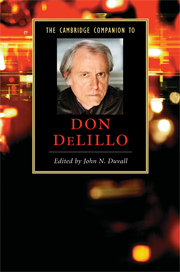Book contents
- Frontmatter
- Introduction: The power of history and the persistence of mystery
- PART I AESTHETIC AND CULTURAL INFLUENCES
- 1 DeLillo and modernism
- 2 DeLillo, postmodernism, postmodernity
- PART II EARLY FICTION
- PART III MAJOR NOVELS
- PART IV THEMES AND ISSUES
- Conclusion: Writing amid the ruins: 9/11 and Cosmopolis
- Select bibliography
- Guide to further reading
- Index
- Series List
2 - DeLillo, postmodernism, postmodernity
from PART I - AESTHETIC AND CULTURAL INFLUENCES
Published online by Cambridge University Press: 28 June 2008
- Frontmatter
- Introduction: The power of history and the persistence of mystery
- PART I AESTHETIC AND CULTURAL INFLUENCES
- 1 DeLillo and modernism
- 2 DeLillo, postmodernism, postmodernity
- PART II EARLY FICTION
- PART III MAJOR NOVELS
- PART IV THEMES AND ISSUES
- Conclusion: Writing amid the ruins: 9/11 and Cosmopolis
- Select bibliography
- Guide to further reading
- Index
- Series List
Summary
The reason for the initial groundswell of interest in Don DeLillo in the mid- 1980s and the reason that White Noise (1985) has quickly become one of the most frequently taught postwar novels is that DeLillo is seen as representing the turn to postmodernism in American literature. But the vital question is: in what sense is DeLillo a postmodern writer? Is it his detailed anthropological attention to those aspects of contemporary Western – and perhaps specifically American – life in the age of media saturation and globalized free market capitalism that is characterized by the term postmodernity? Or is it his deployment of a set of stylistic techniques that makes him an exponent of a new artistic register that goes by the name of postmodernism? Or is it a stance of opposition to contemporary economic and political trends that renders him less a gung-ho postmodernist than a determined if somewhat oblique antipostmodernist? The basic debate that has fascinated many readers of DeLillo is whether his writing is able to maintain a critical distance from the culture he describes. Put simply, is his writing a symptom, a diagnosis, or an endorsement of the condition of postmodernity?
After modernism
The critics who have examined DeLillo’s recurrent interest in modernist writers such as James Joyce and William Faulkner and in artistic techniques such as cinematic montage and literary surrealism are undoubtedly correct in suggesting that he has a greater formal and spiritual affinity with the early twentieth-century avant-garde in particular and modernism in general than with other contemporary postmodernist writers. But the irony is that it is the explicitness with which DeLillo acknowledges his enormous debt to modernism that ends up rendering him postmodern.
- Type
- Chapter
- Information
- The Cambridge Companion to Don DeLillo , pp. 27 - 40Publisher: Cambridge University PressPrint publication year: 2008
- 10
- Cited by

